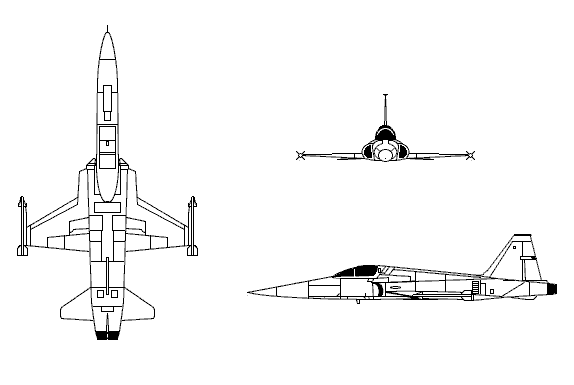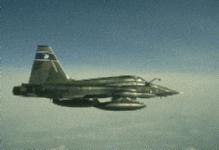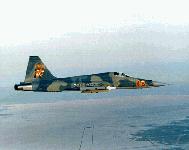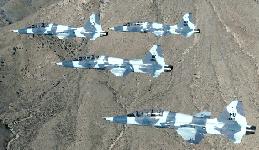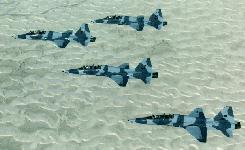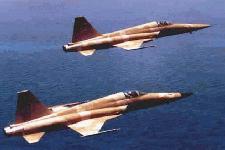
F-5 Tiger2
VRML by Soji Yamakawa



Although all F-5A production was intended for MAP, in October 1965, the USAF "borrowed" 12 combat-ready F-5As from MAP supplies and sent them to Vietnem with the 4503rd Tactical Fighter Wing for operational service trials. This program was given the code name of *Skoshi Tiger" ("little" Tiger). and it was during this tour of duty that the F-5 picked up its Tiger nickname.
On November 20, 1970, the Northrop entry was declared the winner of the IFA (International Fighter Aircraft) to be the F-5A/B's successor. The emphasis was be on the air-superiority role for nations faced with threats from opponents operating late-generation MiG-21s. An order was placed for five development and 325 production aircraft. In January of 1971, it was reclassified as F-5E. The aircraft came to be known as *Tiger II*The US Navy Fighter Weapons School (the so-called "Top Gun" school) at NAS Miramar acquired a total of ten F-5Es and three F-5Fs for dissimilar air combat training. Because of the F-5's characteristics, which were similar to the MiG-21, was used as 'agressor' aircraft, equipping the FWS and VF-126 at NAS Miramar, plus VF-43 at NAS Oceana. All three units later disposed of their Tiger IIs in favor of the General Dynamics F-16N. These Tiger IIs were passed on to VF-95 at NAS Key West and VFA-127 at NAS Fallon. During FY 1996, VFC-13 moved from NAS Miramar, CA, to NAS Fallon, NV, and transitioned from 12 F/A-18 to 25 F-5 aircraft. VFC-13's flight hour program will increase to offset the scheduled decommissioning of the two remaining Active Component adversary squadrons, VF-45 and VFA-127. This transition to the F-5 adversary aircraft will provide Active and Reserve Navy pilots with air-to-air combat training at significant savings to the taxpayer. Recent estimates show that the F-5 can be operated at one third of what it costs to operate an F/A-18.
Specifications | ||
| F-5A Freedom Figher | F-5E Tiger II | |
| Engines | Two General Electric J85-GE-13 turbojets, rated at 2720 lb.s.t., 4080 lb.s.t. with afterburning. | Two General Electric J85-GE-21A turbojets, 5000 lb.s.t. with afterburning. |
| Maximum speed | 925 mph (Mach 1.4) at 36,000 feet. Maximum cruising speed: 640 mph (Mach 0.97) at 36,000 feet | Maximum cruising speed without afterburning: Mach 0.98 at 36,000 feet. |
| Service ceiling | 50,500 feet. | 51,800 feet |
| Range | with maximum fuel -- 1387 miles. Combat radius with maximum payload -- 195 miles Combat radius with maximum fuel and two 530-pound bombs 558 miles. |
with maximum fuel -- 1543 miles Combat radius with maximum fuel and 2 Sidewinder missiles -- 656 miles. |
| wingspan | 25 feet 3 inches, | 26 feet 8 inches |
| length | 47 feet 2 inches, | 48 feet 2 inches |
| height | 13 feet 2 inches, | 13 feet 4 inches |
| wing area | 170 square feet. | 186 square feet |
| Weights: | 8085 pounds empty, 11,477 pounds combat, 13,433 pounds gross, 20,677 pounds maximum takeoff | 9683 pounds empty, 13,350 pounds combat, 15,745 pounds gross, 24,676 pounds maximum takeoff. |
| Armament | two 20-mm cannon in the fuselage nose. Two AIM-9 Sidewinderat the wingtips Five pylons carry up to 6200 pounds of ordinance or fuel tanks loads can include four air-to-air missiles, Bullpup air-to-surface missiles, bombs, up to 20 unguided rockets, or external fuel tanks. | two 20-mm M39A2 cannon with 280 rpg two AIM-9 Sidewinder missiles at wingtips Five pylons can carry up to 7000 pounds of ordnance or fuel |
| VRML 3-D Model |
 F-5 Tiger2 VRML by Soji Yamakawa |
